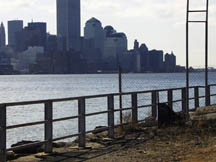City residents who just can’t get enough of the waterfront view of Manhattan will soon have another vantage point to consider thanks to the generosity of the Stevens Institute of Technology. Under the terms of an agreement signed last week between the university and the city, Stevens will lease a narrow two-block spit of waterfront property to the city for $1 per year for the next 50 years so that the city can turn it into a waterfront park. The land, which sits between Sinatra Drive and the Hudson River and runs from what would be Eighth street to Tenth Street if those streets connected to the water, will be known as Castle Point Park when it is completed. City officials say that they will spend almost $3 million in state and city funds to turn the dilapidated stretch into a 60-foot wide path complete with park benches and a 100 foot fishing pier. Almost the entire path will hang out over the river. Plans are also in place to include at least 12 parking spaces for the new facility. Construction could begin as early as this summer and the entire project is likely to be completed in 14 months once it begins, according to Robert Drasheff, the city’s director of human services. “When this is done, Hoboken will give its residents better access to the Hudson River than any other municipality in New Jersey,” said Drasheff. Officials at the Stevens Institute explained that the only viable development option for the land was to turn it into a park since it was such a narrow slice of real estate. State law requires that new development along the waterfront between the George Washington Bridge and the Bayonne Bridge must include a riverfront walkway that is at least 30 feet wide. “The state mandate did not leave a lot of room for development there,” said Cass Burton-Ward, a spokesperson for the university. “Allowing the city to develop a park there in partnership with the university is a win-win situation for everyone involved.” Ultimately, city officials hope to incorporate the park into an 18-mile long Hudson Riverfront Walkway. Right now the city, is in the process of completing construction of a portion of the walkway along the southern waterfront that will connect the Lackawanna terminal to Frank Sinatra Park at Fifth Street. Last week’s announcement, coupled with the private development along the waterfront at the Shipyard and imminent new construction at the Maxwell House factory, leaves the city with only a few small stretches of waterfront property not slated for the development of the walkway. One of those stretches, a parcel just south of the two-block area that the university leased to the city, also belongs to Stevens. Burton-Ward said that the university was looking at plans to develop the area, but stressed that no plans had been finalized. “We are trying to work out a plan that makes sense economically,” she said. “Right now we are considering putting some residential or office space there.”
Another waterfront park on the way, City secures two blocks of riverfront from Stevens
